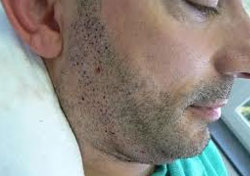Hair thinning is a common condition that affects people even at a very early age. Studies show that more men suffer from this condition than women. But hair loss is not only limited to the scalp and in fact, some people lose hair on their eyebrows, lashes, and beards. Fortunately, there are many options to treat hair loss and one of the most recommended treatments for those suffering from facial hair loss is the beard hair transplant.

Availability of Hair Transplant Procedures
Apart from home medications such as shampoos, vitamins, and serums, people go through hair transplant procedures to treat hair loss. It is deemed to be the most effective solution to such problems. There are several surgical procedures that you can avail of such as mini-grafts, micro-grafts, FUT, and FUE. And with the stiff competition among hair transplant clinics, it won’t be so hard to find surgeons offering their services at reasonable rates. Aside from the typical transplanting of hair on the head, different surgeons and clinics also offer mustache and beard transplants. These surgical procedures are quite similar to the usual method of transplanting healthy though it requires a high level of aesthetic abilities. The procedure is used to thicken an existing beard, or most likely to add hair where none is growing. Primarily, men opt for a beard hair transplant to address a genetic hair loss problem.
How a Beard Hair Transplant Works
Mustache and beard transplants require a more refined hair grafting procedure. It involves the classic Follicular Unit Transplant (FUT), removing hair strip from the scalp, and then isolating follicles separately. Peripheral incisions are performed and usually one or two hair grafts are transplanted simultaneously. It requires hair length of at least 1 centimeter in order to flawlessly alter the hair’s direction in the incisions of approximately 0.7mm – 0.8mm.
Typically, donor hairs are extracted from the scalp because they are close to the natural texture of the facial hair. Furthermore, such procedure entails lesser pain, giving patients the benefit of faster recovery and allowing them to go back to their regular activities two weeks after the surgery. Trimming or shaving of the transplanted hair is necessary so it can re-grow and achieve a natural look. The same is true with the mustache hair transplant, thereby giving a patient more options to treat or remedy certain facial hair problems. Hence, you can expect results to look quite amazing and can be visible in just a few months.
The Possibility of Scarring
After a beard hair transplant procedure, scars might appear in the recipient area as well as the donor area. However, scarring can be avoided if the doctor makes clean and fine slits or incisions. Scars in the donor area will appear linear, approximately 1mm wide, but completely invisible after some time since the spot will be covered by re-growing hair. On the other hand, scars in the recipient area will only be visible when hair is entirely trimmed or shaved off so these things shouldn’t be a cause for concern.
